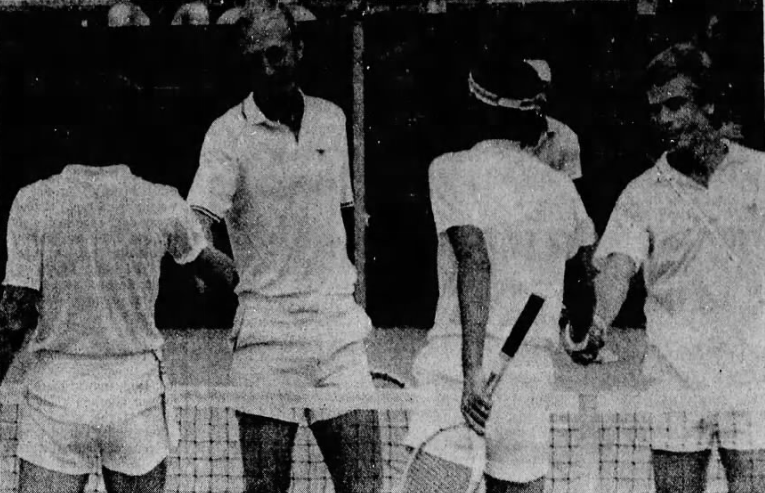
United States Davis Cuppers had a perennial complaint: They played half their ties abroad, where they faced uniformly hostile crowds. Then they came home and heard the same loud, brassy cheers for the opposition.
A small cluster of Chilean fans, it seemed, could make more noise than a sold-out stadium full of laid-back Americans. That was the home team’s experience on the first day of the 1973 Americas Zone final in Little Rock, Arkansas. Tom Gorman and Stan Smith each recorded four-set singles victories. But Smith was underwhelmed by the local support.
“I began to get mad,” Stan said of his feelings when the Chilean contingent got going again during the doubles match on August 5th. “Last year in Santiago, there were 6,000 persons chanting like that [“Chile! Chile! Chile!”] and nowhere did we hear a peep in reply.”
On the second day of the tie, the home fans finally woke up. Only these weren’t just garden-variety Americans packing the grandstand. These were Razorbacks.
Finally, after dropping the first set and losing serve in the second to fall to 25-26 (yes, really–we’ll get back to that shortly), Smith and his partner Erik van Dillen began to hear a roar. It rose to become almost deafening:
Woo, pig! Sooie!
Woo, pig! Sooie!
Woo, pig! Sooie!
Four thousand supporters were “Calling the Hogs,” the rallying cry of the University of Arkansas Razorbacks.
“It was like there were ten cheerleaders leading them in unison,” said Smith. “It was the most tremendous thing I’ve ever heard.”
When the crowd finished their thundering chant–Razorback! Razorback! Razorback!–the Americans felt they were in the match once more. They broke back for 26-all, and the marathon set continued.
* * *
A year earlier in Santiago, the same four men–Smith, van Dillen, Pat Cornejo, and Jaime Fillol–had gone five sets at the same stage of the competition. In 1973, they fought an even tighter battle.
The Chileans took the first set, 9-7. The two Americans were among the best doubles players in the world, but until recently, schedules had prevented them from teaming up since the previous year’s Davis Cup final in Romania. The rust showed. Van Dillen recognized that they weren’t intimidating the visitors. They weren’t showing their opponents enough variety.
The second set saw the two teams settle into their respective trenches. They held serve for fifty consecutive games.
Yes, fifty.
The tiebreak was making rapid inroads in top-level tennis. Most tournaments had adopted it: Television more or less required that match times be more predictable. Even Wimbledon joined the stampede in 1973, leaving only the deciding set to be played the old-fashioned way. Davis Cup was the last holdout for tennis purists.
In the 51st game, Smith finally faltered, netting two volleys and a backhand smash to hand the Chileans that 26-25 advantage. The vocal might of Arkansas saved the day, and the home side broke Fillol to stay alive.
17 games later, it was van Dillen’s turn to slip. The visitors took a 35-34 advantage, and once again, the Americans recovered. Smith missed an easy smash to hand the Chileans another break for 38-37. This time, Fillol finished the job at love.
39-37: The most games ever played in a single Davis Cup set. It represented nearly four hours of tennis. The Americans had squandered 12 set points.
But Smith and van Dillen weren’t dwelling on their new entry in the record book. They faced a 0-2 deficit in the pivotal doubles rubber, and they didn’t intend to quit now.
The home team regrouped and altered their strategy. The six-foot, four-inch Smith moved more frequently across the center line, giving the Chileans something to think about and forcing more errors. The Americans finally broke to secure an 8-6 third set, then raced to a 5-1 advantage in the fourth before darkness halted the match.
The four men had played for nearly six hours, and the score reflected a near-draw. The momentum, at least, rested with Smith and van Dillen.
The following day, Team USA came back with an even sounder tactical plan and required just ten more games. They secured the match and the tie, 7-9, 37-39, 8-6, 6-1, 6-3. The United States advanced to the Inter-Zone semi-finals. In two weeks’ time, they would host Romania, the 1972 runner-up.
* * *
Tiebreaks would have changed this particular tie beyond recognition. Was it time for the Davis Cup to join the modern era? One reporter made the rounds of the American locker room to find out what the victors thought.
Captain Dennis Ralston said no: “The Davis Cup is a test of ability, endurance, and conditioning.” Gorman felt the same, having opened his first singles match by winning a 17-15 set from Fillol. “Stamina is a big part of the Davis Cup,” he said. “I like being in good shape.”
Smith and van Dillen had less to say about it, perhaps because they were still out of breath. Still, van Dillen voiced his support for tradition. “This way, they have to beat us,” he said.
Cornejo and Fillol had turned in one of the sterling doubles performances of the year. With the tiebreak rule in place, the story might have ended differently. But against the combined forces of Smith’s power, van Dillen’s net coverage, and the 4,000-strong voice of Arkansas, they couldn’t quite grab three traditional, advantage sets.
* * *
This post is part of my series about the 1973 season, Battles, Boycotts, and Breakouts. Keep up with the project by checking the TennisAbstract.com front page, which shows an up-to-date Table of Contents after I post each installment.
You can also subscribe to the blog to receive each new post by email: